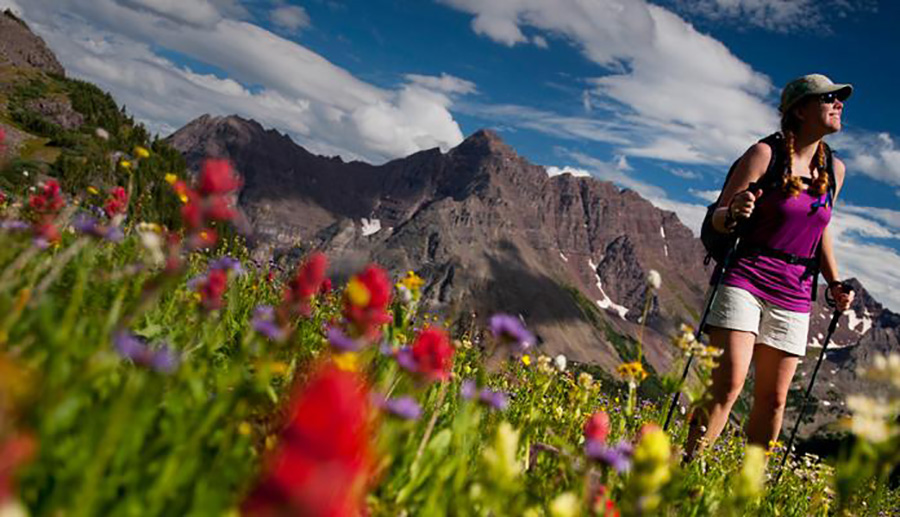According to DestiMetric’s monthly Market Briefing by Inntopia, occupancy and revenue at western mountain destinations at the midpoint of summer 2020 continue to be dramatically lower than last summer despite gaining ground as outdoor mountain activities captured visitors for overnight stays.
The month of July showed an appreciable recovery in bookings and the strongest booking month since February from data it compiled from Colorado, Utah, Nevada, California, Idaho, and Wyoming.
The lead-time for advance bookings became considerably shorter in recent months. Bookings made in July for arrival in July were up 58.7 percent compared to bookings made in July 2019 for arrival in that month, while bookings for arrival in August are up 26.3 percent. Although bookings in July for arrival in the months of September through December did not keep up with last year’s booking pace, all 6 months, except October, saw an increase in occupancy rates signaling that travelers are more confident reserving overnight stays.
“The booking pace and ability to fill in vacancies are the two most crucial metrics that we are monitoring right now, and July turned out to be an excellent month in both categories,” reported Tom Foley, senior vice president for business operations and analytics for Inntopia. “Having evidence that visitors are now returning to destination travel is creating vital opportunities for lodging properties to better understand what conditions visitors are looking for in overnight travel and how to best manage capacity issues as resorts and properties continue to make strategic operational decisions for the upcoming winter.”
According to Desmetrics, there has been a 6 percent increase in the Average Daily Rate (ADR) for July compared to July 2019; however, not enough to offset the steep decline in occupancy with revenue down 23.8 percent compared to last July’s figures—although compared to June’s revenues (down 62 percent), it still provides proof of recovery.
Looking at the full summer season from May through October, occupancy is down 47.3 percent for the 6 month period, but ADR for the period is up 9.4 percent for the full summer with moderate gains in all months except May and June. Rate strength could not offset the low occupancy, and the seasonal summer revenue loss is 43.1 percent as of July 31.
“Pent-up demand creates an interesting dynamic where there is a high volume of bookings and high rates, but a relatively short booking window,” said Foley. He compared the situation to an ocean wave that, after it crests, is expected to subside. Foley’s projection was that the resolution of that wave would be within approximately 45 days
“Because of this intense demand, western mountain resorts made some significant progress with bookings during July compared to last month, and considering the challenges presented by COVID-19, any positive news is notable,” continued Foley. “And while many regions of the country have experienced alarmingly high surges in COVID-19 cases, western mountain resorts were relatively clear of any major resurgence. That stabilization of new cases, combined with strong demand and careful re-openings, helped drive an increased booking pace and to fill-in some lodging capacity.”
Foley further emphasized how dramatic the situation has been, and will continue to be, by saying, “make no mistake, the industry scaled a cliff in July and the rest of a very steep and daunting mountain climb remains ahead as we forge forward into an uncertain winter.”
Economic Measurements
For the fourth consecutive month, the Dow Jones Industrial Average (DJIA) increased and was up 2.8 percent compared to last month but remains two percent lower than last year at this time. After two months of moderate increases, the Consumer Confidence Index (CCI) dropped 5.7 points and, as of July 31, is 31.8 percent lower than it was in July 2019. The national unemployment rate dropped to 10.2 percent (from 11.1 percent in June) as employers exceeded analysts’ expectations and added 1.8 million jobs during the month.
“While Wall Street is showing considerable optimism about the eventual recovery from the pandemic … consumer confidence is unsteady, 30 million people remain unemployed, government relief programs have expired and talks for extending financial support have stalled in Congress,” said Foley.
Looking Ahead To Winter Months
Early data for the winter months mirrors summer patterns as of July 31. Aggregated occupancy on-the-books for arrivals in November through January is down 38 percent compared to the same time last year with declines being reported in all three months. ADR for those months is down 2 percent compared to last winter at this time. November is showing an increase in daily rates of 17.6 percent, but December and January are both declining.
“At the midpoint of summer, the situation is less frenzied than it was two months ago as properties have taken thoughtful steps toward sustainable re-openings and there have been modest increases in overnight visitors,” said Foley. “Strong rates and consistent short-lead bookings are encouraging for the near future, but the lack of long-lead reservations for the crucial winter season is troubling. However, lodging properties are facing the uncertainty of ski resort operational plans, return to school schedules, the trajectory of COVID-19 cases, the presidential election, declining consumer confidence, and shifts in key economic indicators in the months ahead. The headwinds the industry is facing are significant and that is before we even factor in what kind of snow year it will be”.
Photo courtesy Aspen Snowmass













